Effects of Moisture Content and Grain Direction on the Elastic Properties of Beech Wood Based on Experiment and Finite Element Method
Abstract
:1. Introduction
2. Materials and Methods
2.1. Materials
2.2. Configuration of Testing Specimens
2.3. Moisture Conditioning of Testing Specimens According to Different Targeted Moisture Contents
2.4. Testing Methods
2.4.1. Measurement of Compressive Yield Strength of Beech Wood
2.4.2. Measurement of Elastic Constants Based on the Electrometric Method
2.4.3. Simulation of Wood’s Compressive Performance Based on FEM
2.5. Experimental Design
2.6. Statistical Analysis
3. Results and Discussions
3.1. Compressive Yield Strength of Beech Wood with Different Moisture Contents and Grain Directions
3.2. Compressive Elastic Contents of Beech Wood with different Moisture Contents and Grain Depictions
3.3. Shear Modulus of Beech Wood with different Moisture Contents and Grain Directions
3.4. Moisture Sensitivity of Different Elastic Constants of Beech Wood
3.5. Comparison of the Results Obtained by Finite Element Method and Experiment Method
4. Conclusions
- Compared with the moisture content, the grain direction had a stronger effect on the elastic constants. The interactive effects of moisture with grain direction did also had significant effects on the elastic constants of beech wood. It suggested that moisture was one of the factors that contributed to that wood along the transverse direction was more likely to enter the plastic zone than that of longitude direction.
- This research followed the rule of σl > σr > σt, El > Er > Et and Glr > Glt > Grt, with regarded to each moisture content. It demonstrated that, when under the influence of moisture, the wood still had the anisotropy; however, the moisture weakened the anisotropy of beech wood’s compressive yield strength and its modulus of elasticity.
- The decay function can be used to fit the experimental results well, and the fitting formulas could predict the value of elastic constants within moisture contents of 5%–60%; the R2 values were all above 0.95.
- The moisture sensitivity of various elastic constants was different. It suggested that the moisture sensitivity of σl was bigger than that of σr and σt, while the moisture sensitivity of El was smaller than that of Er and Et, which demonstrated that moisture sensitivity of compressive yield strength was higher than its stiffness when wood is along the longitude direction. Besides this, the moisture sensitivity of Grt was greater than those of Glr and Glt.
- FEM can be used to simulate the compression performance of wood with a wide range of moisture contents (5%–60%). The trend shown in result of FEM was consistent with the experiment in terms of the effects of moisture content and grain direction. The relative error between the compressive yield strength obtained by FEM and that attained by experiment method ranged from 0.49% to 16.10%.
Author Contributions
Funding
Acknowledgments
Conflicts of Interest
References
- Fang, L.; Zeng, J.; Zhang, X.H.; Wang, D. Effect of Veneer Initial Moisture Content on the Performance of Polyethylene Film Reinforced Decorative Veneer. Forests 2021, 12, 102. [Google Scholar] [CrossRef]
- Pan, F.Q.; Feng, X.H.; Wu, Z.H. Evaluation of Physical and Mechanical Properties of Canadian Aspen. Chin. J. Wood Sci. Technol. 2020, 34, 9–12. [Google Scholar] [CrossRef]
- Fang, X.Y.; Xu, W.; Huang, Q.T. Research on the Physical and Mechanical Properties of Plantation Small-diameter Teak. For. Mach. Woodwork. Equip. 2019, 47, 40–44. [Google Scholar] [CrossRef]
- Sawata, K. Strength of bolted timber joints subjected to lateral force. J. Wood Sci. 2015, 61, 221–229. [Google Scholar] [CrossRef] [Green Version]
- Wang, X.H.; Wu, Z.H.; Li, X.Z.; Wang, Z.M.; Zhou, H.J. Effect of Climatic Factors on the Deformation of Solid Wood Composite Door. China For. Prod. Ind. 2015, 5, 16–19. [Google Scholar]
- Hu, W.G.; Liu, N.; Guan, H.Y. Experimental Study of the Contact Forces and Deformations of Mortise-and-Tenon Joints Considering the Fits and Grain Orientations of the Tenon. Bioresources 2019, 14, 8728–8737. [Google Scholar] [CrossRef]
- Zhao, Z.Y.; Wu, D.; Huang, C.H.; Zhang, M.; Umemura, K.; Yong, Q. Utilization of Enzymatic Hydrolysate from Corn Stover as a Precursor to Synthesize an Eco-friendly Adhesive for Plywood II: Investigation of appropriate manufacturing conditions, curing behavior, and adhesion mechanism. J. Wood Sci. 2020, 66, 1–10. [Google Scholar] [CrossRef]
- Aydin, T.Y.; Ozveren, A. Effects of Moisture Content on Elastic Constants of Fir Wood. Eur. J. Wood Wood Prod. 2019, 77, 63–70. [Google Scholar] [CrossRef]
- Báder, M.; Németh, R. Moisture-dependent Mechanical Properties of Longitudinally Compressed Wood. Eur. J. Wood Wood Prod. 2019, 77, 1009–1019. [Google Scholar] [CrossRef] [Green Version]
- Jiang, Z.H.; Wang, H.K.; Tian, G.L.; Liu, X.E.; Yu, Y. Sensitivity of Several Selected Mechanical Properties of MOSO Bamboo to Moisture Content Change under the Fiber Saturation Point. Bioresources 2012, 7, 5048–5058. [Google Scholar] [CrossRef] [Green Version]
- Koponen, S.; Toratti, T.; Kanerva, P. Modeling Longitudinal Elasticity and Shrinkage Properties of Wood. Wood Sci. Technol. 1989, 23, 55–63. [Google Scholar] [CrossRef]
- Hering, S.; Keunecke, D.; Niemz, P. Moisture-dependent Orthotropic Elasticity of Beech Wood. Wood Sci. Technol. 2012, 46, 927–938. [Google Scholar] [CrossRef] [Green Version]
- Roszyk, E.; Stachowska, E.; Majka, J.; Mania, P.; Broda, M. Moisture-dependent Strength Properties of Thermally-Modified Fraxinus Excelsior Wood in Compression. Materials 2020, 13, 1647. [Google Scholar] [CrossRef] [Green Version]
- Zhong, W.Z.; Song, S.C.; Huang, X.C.; Hao, Z.M.; Xie, Z.R.; Chen, G. Research on Static and Dynamic Mechanical Properties of Spruce Wood by Three Loading Directions. Chin. J. Theor. Appl. Mech. 2011, 43, 1141–1150. [Google Scholar]
- Yang, N.; Zhang, L. Investigation of Elastic Constants and Ultimate Strengths of Korean Pine from Compression and Tension Tests. J. Wood Sci. 2018, 64, 85–96. [Google Scholar] [CrossRef] [Green Version]
- Wu, Y.M.; Huang, Y.F.; Gao, Z.Q.; Wang, Y.W.; Li, R. Research Development of Influencing Factors of Stress—Strain Relationship under Wood Transverse Compression. China For. Prod. Ind. 2018, 45, 11–16. [Google Scholar]
- Hu, W.G.; Chen, B.R.; Zhang, T.X. Experimental and Numerical Studies on Mechanical Behaviors of Beech Wood under Compressive and Tensile States. Wood Res. 2021, 66, 27–37. [Google Scholar] [CrossRef]
- ASTM E104-02. Standard Practice for Maintaining Constant Relative Humidity by Means of Aqueous Solutions; ASTM International: West Conshohocken, PA, USA, 2012. [Google Scholar]
- Cheng, J.Q.; Yang, J.J.; Liu, P. Chapter 7—The Important Wood Material of China. In Wood Science, 1st ed.; China Forestry Publishing House: Beijing, China, 1985; pp. 994–996. (In Chinese) [Google Scholar]
- CNS GB/T1939-2009. Method of Testing in Compressive Perpendicular to Grain of Wood; National standard of the People’s Republic of China: Beijing, China, 2009. (In Chinese) [Google Scholar]
- Wang, L.Y.; Lu, Z.Y.; Shen, S.J. Study on Twelve Elastic Constant Values of Betula Platyphylla Suk. Wood. J. Beijing For. Univ. 2003, 6, 64–67. (In Chinese) [Google Scholar]
- Hu, W.G.; Guan, H.Y. Study on Elastic Constants of Beech in Different Stress States. J. For. Eng. 2017, 2, 31–36. [Google Scholar]
- Liu, F.L.; Zhang, H.J.; Jiang, F.; Wang, X.P.; Guan, C. Variations in Orthotropic Elastic Constants of Green Chinese Larch from Pith to Sapwood. Forests 2019, 10, 456. [Google Scholar] [CrossRef] [Green Version]
- Taguchi, A.; Murata, K.; Nakamura, M.; Nakano, T. Scale Effect in the Anisotropic Deformation Change of Tracheid Cells During Water Adsorption. Holzforschung 2011, 65, 253–256. [Google Scholar] [CrossRef] [Green Version]
- Yang, L.; Liu, H.H. Study of the Collapse and Recovery of Eucalyptus Urophydis during Conventional Kiln Drying. Eur. J. Wood Wood Prod. 2021, 79, 129–137. [Google Scholar] [CrossRef]
- Liu, Y.X.; Zhao, G.J. Science of Wood Resources and Materials, 1st ed.; China Forestry Publishing House: Beijing, China, 2004; pp. 140–142. [Google Scholar]
- Yamamoto, H.; Sassus, F.; Ninomiya, M.; Gril, J. A Model of Anisotropic Swelling and Shrinking Process of Wood. Wood Sci. Technol. 2001, 35, 167–181. [Google Scholar] [CrossRef]
- Ozyhar, T.; Hering, S.; Niemz, P. Moisture-dependent Orthotropic Tension-compression Asymmetry of Wood. Holzforschung 2013, 67, 395–404. [Google Scholar] [CrossRef] [Green Version]
- Jiang, J.L.; Bachtiar, E.V.; Lu, J.X.; Niemz, P. Comparison of Moisture-dependent Orthotropic Young’s Moduli of Chinese Fir Wood Determined by Ultrasonic Wave Method and Static Compression or Tension Tests. Eur. J. Wood Wood Prod. 2018, 76, 953–964. [Google Scholar] [CrossRef]
- Korkmaz, O.; Buyuksari, U. Effects of Moisture Content on Mechanical Properties of Micro-size Oak Wood. Bioresources 2019, 14, 7655–7663. [Google Scholar] [CrossRef]
- Maaß, M.C.; Saleh, S.; Militz, H.; Volkert, C.A. The Structural Origins of Wood Cell Wall Toughness. Adv. Mater. 2020, 32. [Google Scholar] [CrossRef] [PubMed] [Green Version]
- Uhmeier, A.; Salmen, L. Influence of Strain Rate and Temperature on the Radial Compression Behavior of Wet Spruce. J. Eng. Technol. 1996, 118, 289–294. [Google Scholar] [CrossRef]
- Nairn, J.A. Numerical Simulations of Transverse Compression and Densification in Wood. Wood Fiber Sci. 2006, 38, 122–139. [Google Scholar]
- Güntekin, E.; Aydın, T.Y. Determination of Elastic Constants for Anatolian Black Pine Wood Using Ultrasound. In Proceedings of the World Conference on Timber Engineering, Vienna, Austria, 22–25 August 2016; pp. 976–981. [Google Scholar]
- Güntekin, E.; Aydın, T.Y.; Niemz, P. Some Orthotropic Mechanical Properties of Sessile Oak (Quercus petrea) as Influenced by Moisture Content. Eurasian J. For. Sci. 2016, 4, 40–47. [Google Scholar] [CrossRef] [Green Version]
- Mizutani, M.; Ando, K. Influence of a Wide Range of Moisture Contents on the Poisson’s Ratio of Wood. J. Wood Sci. 2015, 61, 81–85. [Google Scholar] [CrossRef]
- Bachtiar, E.V.; Sanabria, S.J.; Mittig, J.P.; Niemz, P. Moisture-dependent Elastic Characteristics of Walnut and Cherry Wood by Means of Mechanical and Ultrasonic Test Incorporating Three Different Ultrasound Data Evaluation Techniques. Wood Sci. Technol. 2017, 51, 47–67. [Google Scholar] [CrossRef]
- Kruger, R.; Buchelt, B.; Wagenfuhr, A. New Method for Determination of Shear Properties of Wood. Wood Sci. Technol. 2018, 52, 1555–1568. [Google Scholar] [CrossRef]
- Bahmanzad, A.; Clouston, P.L.; Arwade, S.R.; Schreyer, A.C. Shear Properties of Eastern Hemlock with Respect to Fiber Orientation for Use in Cross Laminated Timber. J. Mater. Civ. Eng. 2020, 2, 1–11. [Google Scholar] [CrossRef]
- Dinwoodie, J.M. Timber: Its Nature and Behavior, 2nd ed.; E & FN Spon: London, UK, 2000; pp. 187–229. [Google Scholar]
- Güntekin, E.; Demiratli, S. Influence of Moisture Content on Some Elastic Constants of Black Pine Subjected to Compression. ProLigno 2017, 13, 21–26. [Google Scholar]
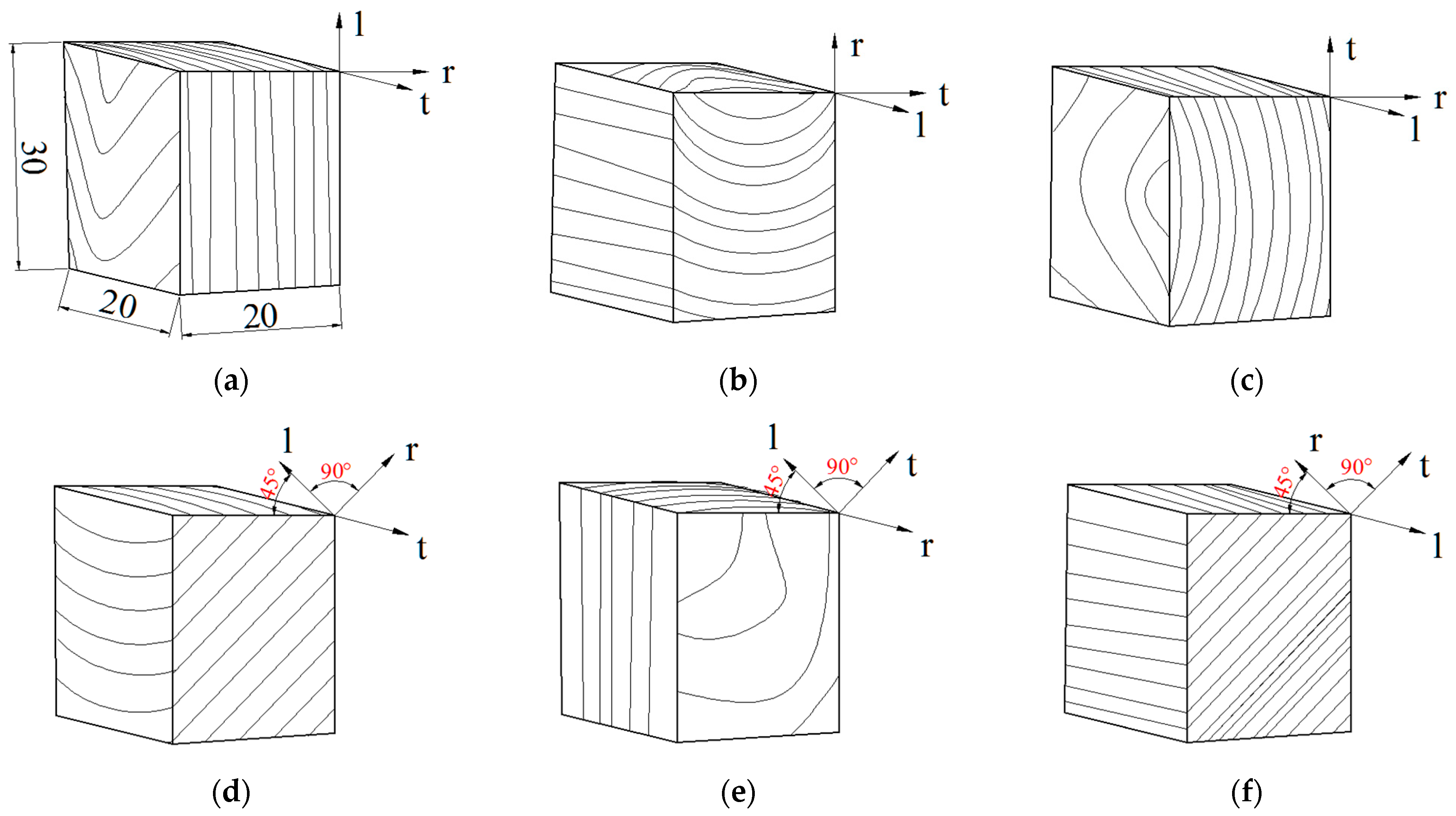
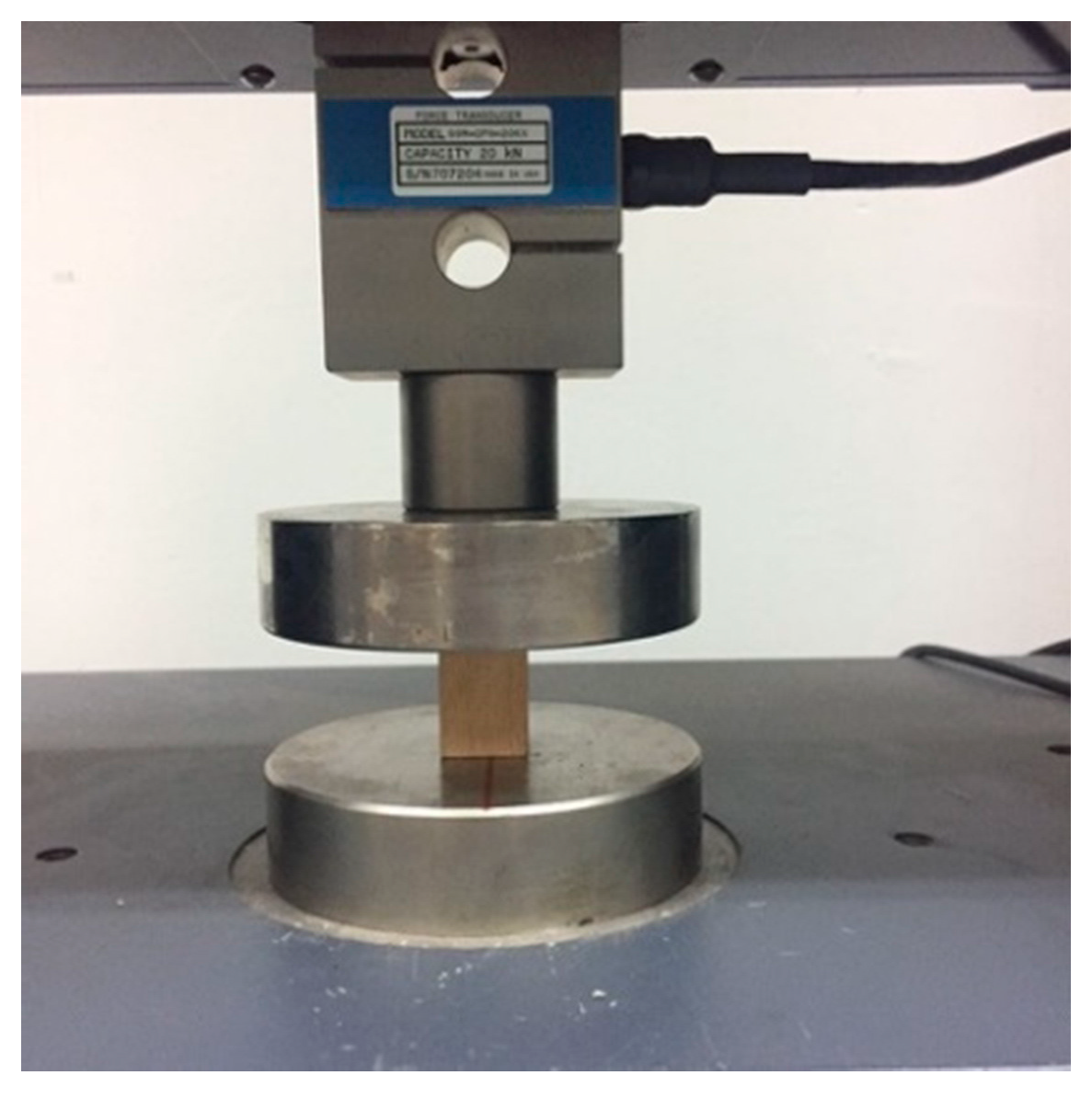


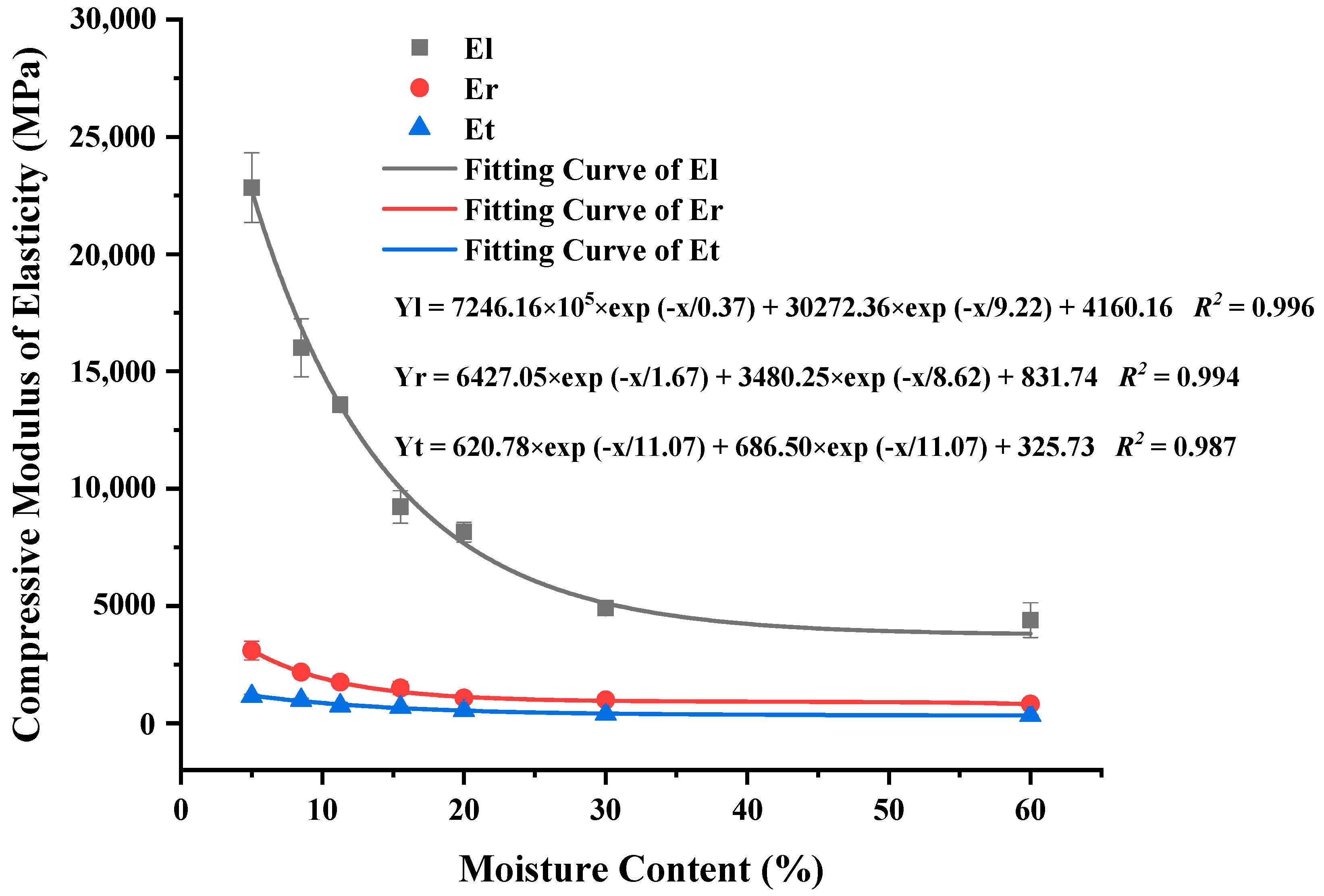
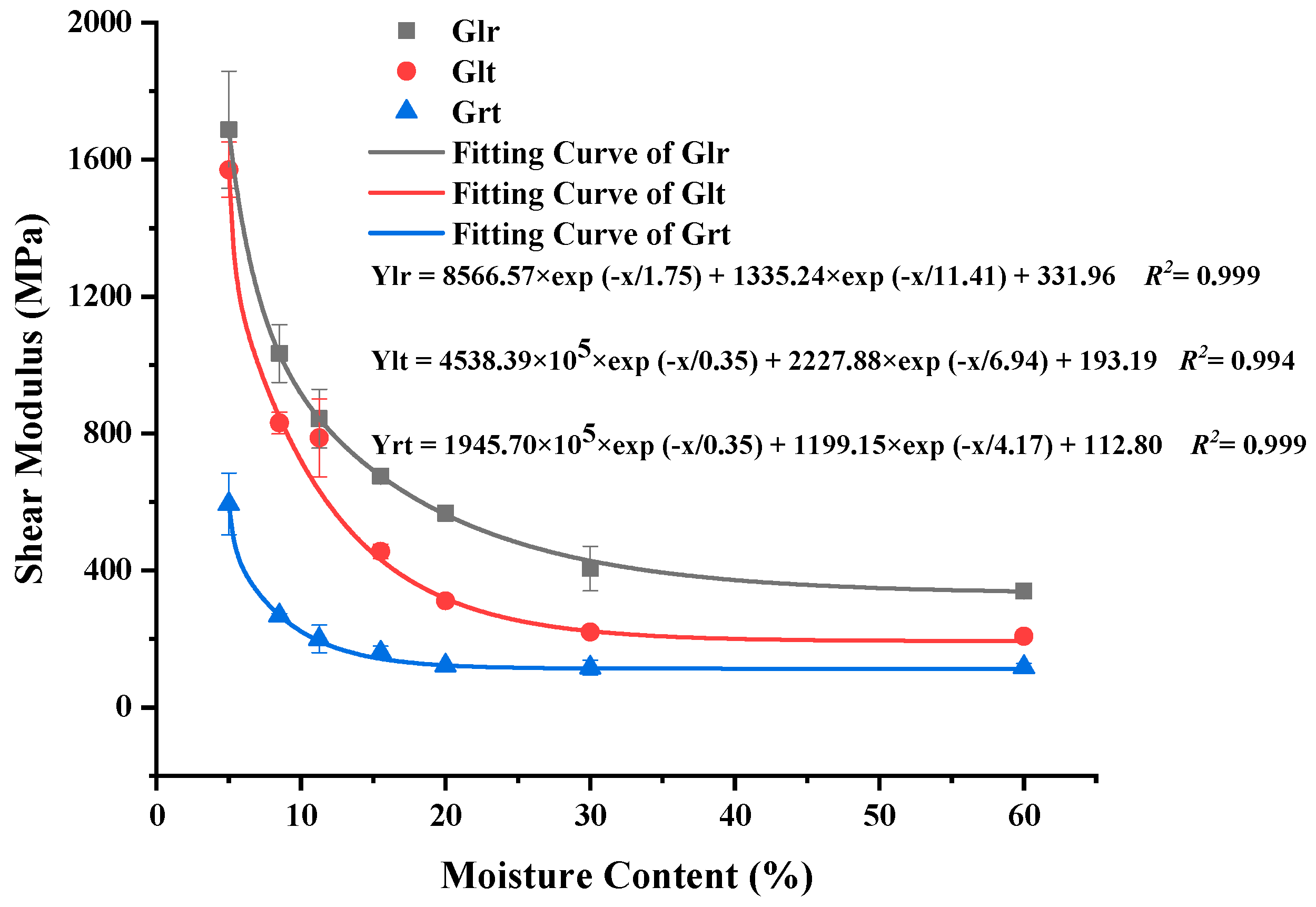
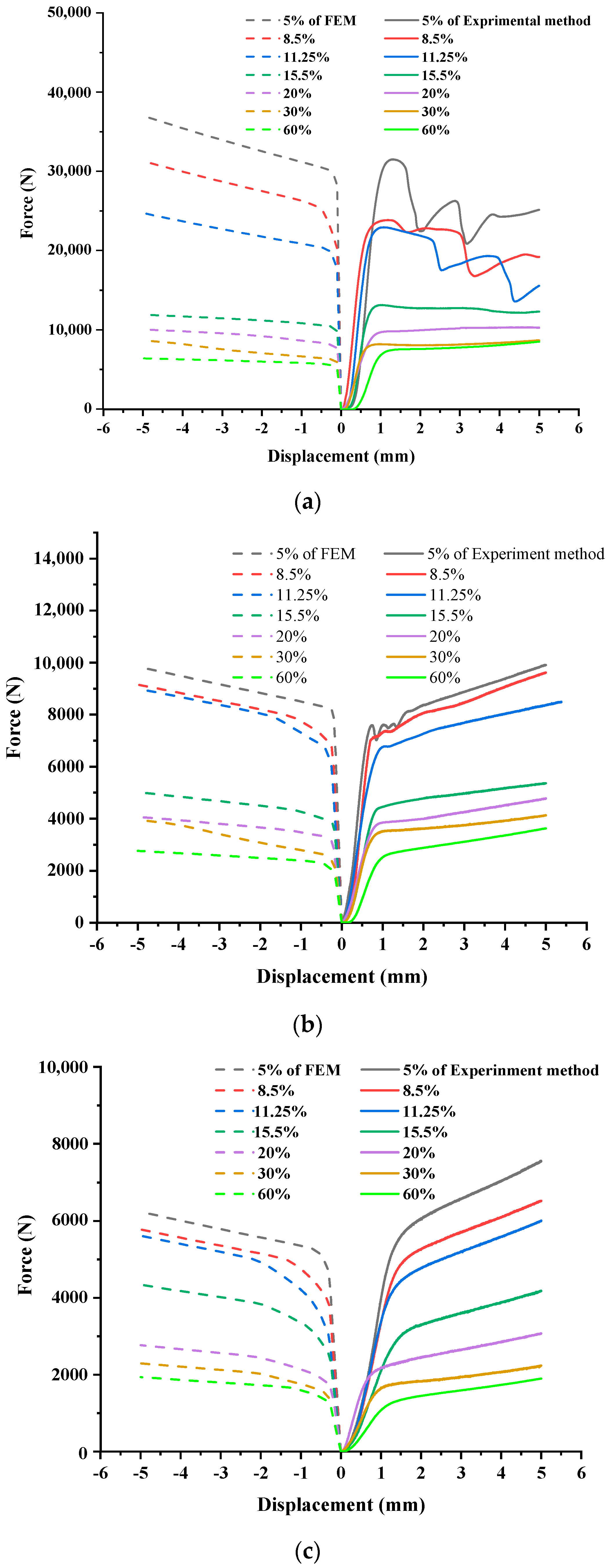
| Types | Humidity | Targeted Moisture Content | Measured Moisture Content |
|---|---|---|---|
| Potassium acetate (CH3COOK) | 23% | 5% | 4.63 ± 0.27 |
| Potassium carbonate (K2CO3) | 43% | 8.5% | 8.74 ± 0.34 |
| Sodium chloride (NaCl) | 75% | 15.5% | 15.8 ± 0.49 |
| potassium chloride (KCl2) | 89% | 20% | 18.74 ± 0.75 |
| Potassium sulfate (K2SO4) | 98% | 30% | 28.85 ± 1.03 |
| Water | - | 60% | 57.18 ± 1.65 |
| Specimen Type | Moisture Content (%) | ||||||
|---|---|---|---|---|---|---|---|
| 5 | 8.50 | 11.25 | 15.50 | 20 | 30 | 60 | |
| (N) | |||||||
| a 1 | 3000–6000 | 3000–6000 | 3000–6000 | 2000–5000 | 1000–4000 | 1000–4000 | 1000–4000 |
| b | 800–1500 | 800–1500 | 800–1500 | 600–1000 | 600–1000 | 600–1000 | 600–1000 |
| c | 800–1500 | 800–1500 | 800–1500 | 600–1000 | 300–700 | 300–700 | 300–700 |
| d–f | 800–1500 | 800–1500 | 800–1500 | 600–1000 | 600–1000 | 600–1000 | 600–1000 |
| Monitored Factors | F Value | p-Value |
|---|---|---|
| Moisture content | 185.39 | <0.05 |
| Grain direction | 890.34 | <0.05 |
| Moisture content × Grain direction | 62.80 | <0.05 |
| Grain Direction | Moisture Content | ||||||
|---|---|---|---|---|---|---|---|
| 5.00 | 8.50 | 11.25 | 15.50 | 20.00 | 30.00 | 60.00 | |
| (MPa) | |||||||
| σl | 69.74 (9.64) 1 a 2 | 50.07 (14.71) b | 43.08 (12.31) c | 24.10 (9.15) d | 18.69 (10.74) e | 14.77 (10.63) f | 12.74 (12.96) f |
| σr | 17.27 (9.55) g | 16.67 (13.31) h | 14.90 (10.11) i | 9.23 (14.59) j | 7.54 (22.65) k | 5.43 (20.41) l | 4.99 (16.75) l |
| σt | 11.65(16.09) m | 9.63 (20.67) n | 8.74 (14.98) o | 6.15 (14.60) p | 4.12 (15.46) q | 3.56 (9.30) r | 3.11 (20.26) r |
| Monitored Factors | F Value | p-Value |
|---|---|---|
| Moisture content | 630.556 | <0.05 |
| Grain direction | 6900.048 | <0.05 |
| Moisture content × Grain direction | 383.336 | <0.05 |
| Grain Direction | Moisture Content | ||||||
|---|---|---|---|---|---|---|---|
| 5.00 | 8.50 | 11.25 | 15.50 | 20.00 | 30.00 | 60.00 | |
| (MPa) | |||||||
| El | 22,839.69 (6.52) 1 a 2 | 16,005.90 (7.71) b | 13,580.50 (0.75) c | 9229.60 (7.49) d | 8151.67 (5.15) e | 4902.51 (5.90) f | 4395.76 (16.83) f |
| Er | 3100.59 (12.85) g | 2178.29 (8.44) h | 1747.33 (12.89) i | 1498.65 (19.07) j | 1073.96 (11.53) k | 992.94 (15.51) l | 818.87 (3.12) l |
| Et | 1145.63 (7.85) m | 979.46 (8.37) n | 743.96 (18.26) o | 676.92 (8.41) p | 540.78 (6.93) q | 395.37 (6.58) r | 340.38 (4.85) r |
| Grain Direction | Moisture Content | ||||||
|---|---|---|---|---|---|---|---|
| 5.00 | 8.50 | 11.25 | 15.50 | 20.00 | 30.00 | 60.00 | |
| (MPa) | |||||||
| Ulr | 0.8791 (6.38) 1 a 2 | 0.7382 (0.36) b | 0.5365 (23.75) cf | 0.4393 (17.38) de | 0.3799 (11.64) e | 0.5557 (5.14) f | 0.6595 (15.38) g |
| Ult | 1.2122 (2.56) a | 1.0685 (3.15) b | 0.6158 (4.64) cf | 0.5269 (3.38) de | 0.5047 (13.60) e | 0.6070 (4.43) f | 0.9761 (5.73) g |
| Urt | 0.9048 (7.64) ac | 0.7657 (12.33) bef | 0.8727 (7.74) cd | 0.7995 (6.71) de | 0.7803 (16.62) ef | 0.7039 (14.26) fg | 0.6628 (21.93) g |
| Url | 0.0988 (23.35) aef | 0.0934 (6.47) aef | 0.0618 (30.58) bcd | 0.0508 (20.53) cd | 0.0629 (0.33) d | 0.0911 (34.97) ef | 0.0933 (28.02) f |
| Utr | 0.4171 (6.98) ad | 0.3411 (20.78) bg | 0.470 (9.63) ce | 0.3901 (2.91) df | 0.4672 (16.99) e | 0.3663 (1.92) bfg | 0.3415 (7.85) g |
| Utl | 0.046 (20.00) a | 0.057 (15.10) bdg | 0.029 (28.76) cef | 0.049 (20.55) ad | 0.034 (4.66) ef | 0.036 (11.12) f | 0.059 (2.19) g |
| Moisture Content | (Ulr/El)/(Url/Er) | (Ult/El)/(Utl/Et) | (Urt/Er)/(Utr/Et) |
|---|---|---|---|
| 5.00 | 0.812 | 0.762 | 1.248 |
| 8.50 | 0.930 | 0.875 | 1.027 |
| 11.25 | 0.843 | 0.861 | 1.265 |
| 15.50 | 0.712 | 1.277 | 1.075 |
| 20.00 | 1.213 | 1.024 | 1.178 |
| 30.00 | 0.809 | 0.730 | 1.307 |
| 60.00 | 0.760 | 0.774 | 1.263 |
| Monitored Factors | p-Value | F Value |
|---|---|---|
| Moisture content | <0.05 | 864.593 |
| Grain Direction | <0.05 | 1106.267 |
| Moisture content × Grain direction | <0.05 | 70.624 |
| Grain Direction | Moisture Content | ||||||
|---|---|---|---|---|---|---|---|
| 5.00 | 8.50 | 11.25 | 15.50 | 20.00 | 30.00 | 60.00 | |
| (MPa) | |||||||
| Glr | 1687.17 (10.13) 1 a 2 | 1033.92 (8.17) b | 843.76 (10.19) c | 674.96 (2.76) d | 567.04 (4.06) e | 405.68 (16.06) f | 339.69 (6.54) f |
| Glt | 1570.63 (5.12) g | 830.93 (3.81) h | 787.30 (14.44) i | 455.74 (4.66) j | 311.17 (4.25) k | 220.52 (2.41) l | 207.62 (6.95) l |
| Grt | 594.23 (15.17) m | 269.11 (1.48) n | 199.90 (20.10) o | 160.41 (11.22) p | 122.28 (1.68) q | 116.34 (18.65) r | 117.85 (8.57) r |
| Reference Literature | Wood Species | Moisture Sensitivity of Elastic Constants | ||||||||
|---|---|---|---|---|---|---|---|---|---|---|
| (%) | ||||||||||
| σl | σr | σt | El | Er | Et | Glr | Glt | Grt | ||
| This study | Beech wood | 6.335 | 5.329 | 5.481 | 5.029 | 5.496 | 5.127 | 4.812 | 5.740 | 6.381 |
| Hering et al. [12] | European beech wood | - | - | - | 2.190 | 2.977 | 3.869 | 1.339 | 2.250 | 2.940 |
| Aydin and Ozveren. [8] | Fir wood | 5.345 | 2.478 | 5.361 | 1.879 | 6.725 | 2.861 | 4.945 | 4.671 | 5.000 |
| Güntekin et al. [35] | Sessile oak wood | 4.234 | 3.786 | 2.975 | 2.903 | 4.027 | 4.001 | - | - | - |
| Güntekin and DEMIRATLI. [41] | Black pine wood | 4.464 | 3.395 | 3.352 | 3.457 | 5.069 | 3.481 | - | - | - |
| Ozyhar et al. [28] | European beech wood | 7.949 | 5.594 | 5.289 | 3.591 | 5.420 | 5.000 | - | - | - |
| Jiang et al. [29] | Chinese fir wood | - | - | - | 4.242 | 6.010 | 8.371 | - | - | - |
| Bachtiar et al. [37] | Walnut wood | - | - | - | 7.503 | 4.185 | 3.039 | 7.748 | 5.295 | 10.858 |
| Bachtiar et al. [37] | Cherry wood | - | - | - | 3.110 | 4.668 | 5.626 | 3.187 | 4.795 | 2.054 |
| Korkmaz and Büyüksar. [30] | Oak wood | 4.341 | - | - | - | - | - | - | - | - |
| Yield Strength | Moisture Content | ||||||
|---|---|---|---|---|---|---|---|
| 5 | 8.5 | 11.25 | 15.5 | 20 | 30 | 60 | |
| (%) | |||||||
| σl | 1.26 | 1.21 | 2.55 | 2.17 | 2.52 | 3.31 | 1.58 |
| σr | 16.10 | 1.92 | 0.86 | 1.89 | 1.93 | 5.10 | 8.64 |
| σt | 0.49 | 0.98 | 13.77 | 3.17 | 4.14 | 3.28 | 2.87 |
Publisher’s Note: MDPI stays neutral with regard to jurisdictional claims in published maps and institutional affiliations. |
© 2021 by the authors. Licensee MDPI, Basel, Switzerland. This article is an open access article distributed under the terms and conditions of the Creative Commons Attribution (CC BY) license (https://creativecommons.org/licenses/by/4.0/).
Share and Cite
Fu, W.-L.; Guan, H.-Y.; Kei, S. Effects of Moisture Content and Grain Direction on the Elastic Properties of Beech Wood Based on Experiment and Finite Element Method. Forests 2021, 12, 610. https://doi.org/10.3390/f12050610
Fu W-L, Guan H-Y, Kei S. Effects of Moisture Content and Grain Direction on the Elastic Properties of Beech Wood Based on Experiment and Finite Element Method. Forests. 2021; 12(5):610. https://doi.org/10.3390/f12050610
Chicago/Turabian StyleFu, Wei-Lian, Hui-Yuan Guan, and Sawata Kei. 2021. "Effects of Moisture Content and Grain Direction on the Elastic Properties of Beech Wood Based on Experiment and Finite Element Method" Forests 12, no. 5: 610. https://doi.org/10.3390/f12050610





